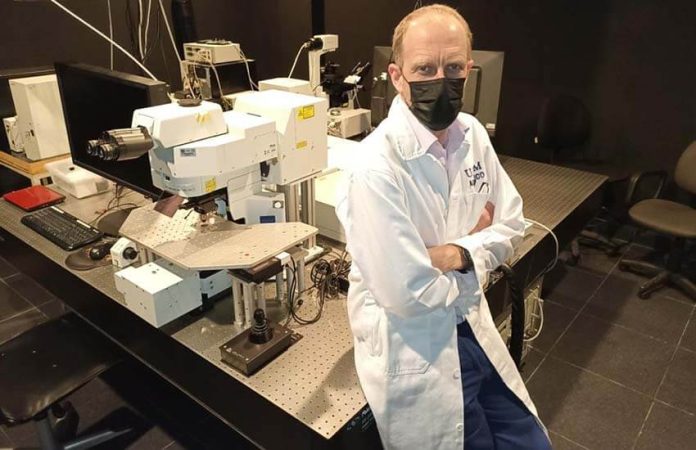Microscopy has been utterly fundamental to our understanding of the life sciences for half a millennium. It is a sad reality, however, that in Mexico, as well as the rest of Latin America, there are disparities in scientific development and infrastructure compared to the rest of the globe.
This means that young Mexican scientists, who simply cannot access the most advanced equipment and techniques, are looking to other parts of the world for a gateway to resources and funding.
In other words, argues Chris Wood, director of the National Laboratory of Advanced Microscopy (LNMA) in Cuernavaca, Morelos, Mexico needs to fight harder to retain scientific talent and create space for innovation. To achieve this, he argues, there is a pressing need for more egalitarian access to core facilities.
At the LNMA, Wood, alongside a team of scientists and specialist technicians, is shifting the narrative on precisely this issue, building connections among laboratories around the country to encourage knowledge exchange and emphasizing the importance of cooperation at every level.
With the support of Conacyt’s National Laboratory Program and the National Autonomous University (UNAM) — the lab complex is located on UNAM’s Morelos campus — the LNMA opened its doors in 2013, part of a national program of national laboratories formed by Conacyt in 2006. Renting its state-of-the-art microscopy equipment to everyone, regardless of their scientific background, the LNMA creates a space for fruitful knowledge exchange and collaborative research for the whole community.
There is not a clinical laboratory in the world that does not contain a microscope of some form since microscopy is essential to our knowledge of anything that exists beyond what we can see with the naked eye. However, many microscopes with the most cutting-edge capabilities cost millions of dollars and are therefore not feasible to purchase for the majority of laboratories. This means that a great deal of exciting new research is stymied by the misfortune of financial circumstances.

Moreover, funding here has historically been granted hierarchically; in Mexico, Conacyt previously granted subsidies to individual scientists who oversee groups of researchers and graduate students. This stratification of access to resources created a gap between the proprietors of expert knowledge, whose research is hugely influential in public policymaking, and the on-the-ground interests of the people served by those policies — as well as new scientific talent whose access to facilities might be restricted.
The LNMA’s founding grew from the need to create a positive tonal shift in scientific infrastructure. In 2011, Conacyt made the groundbreaking commitment to fund this centralized facility, accessible to people of every circumstance, in order to ease the way for burgeoning new domains of scientific discovery, as well as to encourage new progress in more established fields.
Changing an entrenched system, however, has been no easy task: Wood explains that one of the biggest battles fought at the genesis of the laboratory was explaining the concept to the scientific community and overcoming the skepticism surrounding the notion of a widely accessible core facility.
“Given that it takes a significant amount of time for scientific systems to accommodate a system which does not fit the typical model of research,” he says, “it is a risk to switch to running core facilities. But stepping outside of the traditional evaluation systems is worth it to make sure the science we do in Mexico is comparable to science performed anywhere in the world.”
Bioimaging labs in Latin America and across the globe are largely removed from the academic rigmarole of publication. Instead, laboratories like the LNMA exist at the vanguard of knowledge exchange and support for people through human resources and high-quality training.
“We run courses which anyone can attend, and anyone with 200 pesos in their pocket can spend an hour on a microscope,” Wood explains. “The result is that we work with a hugely diverse range of people and that we are able to democratize access and make it a bit more horizontal. We work with photographers, advertising agencies and cinematographers — we never have a dull day!”

Needless to say, it is not merely about the equipment: a collection of machines can do little without a highly specialized team of technicians and researchers who can guide users into getting the best results.
Beyond this, LNMA has invited microscopy labs across the country to join a growing network of cooperating bioimaging laboratories. Wood and his colleagues are embarking on a three-year project which epitomizes their philosophy and aims to connect the Mexican bioimaging community.
Funded by the Chan Zuckerberg Initiative, which encourages collaboration among scientists from around the globe, the LNMA and associate microscopy labs — including the Center for Scientific Research and Higher Education at Ensenada (CICESE) and the Mexican Institute of Social Security (IMSS) — will hold workshops in various institutions across the country on all aspects of microscopy — another way to get scientists across Mexico talking to each other.
“By fomenting relationships through networks like this one, we have the freedom to be multidisciplinary,” says Wood. “We are able to escape academic labels that pigeonhole us into specific fields, and we can instead problem-solve using a diverse team to take a multi-angle approach.”
What this does is create an ecosystem whereby the team at LNMA, working in dynamic exchange with labs across the nation, can take multipronged approaches to the scientific problems brought to them, facilitating a more collaborative understanding of our environment.
“Presenting a united front, it really does change the culture of how you do science,” Wood concludes, striking at the heart of what he and his colleagues do best in Cuernavaca: taking radical steps forward in the advancement of knowledge exchange in bioimaging and microscopy across Latin America by blending the most innovative scientific techniques with a philosophy focused on sharing and collaboration.
Shannon Collins is an environment correspondent at Ninth Wave Global, an environmental organization and think tank. She writes from Campeche.
